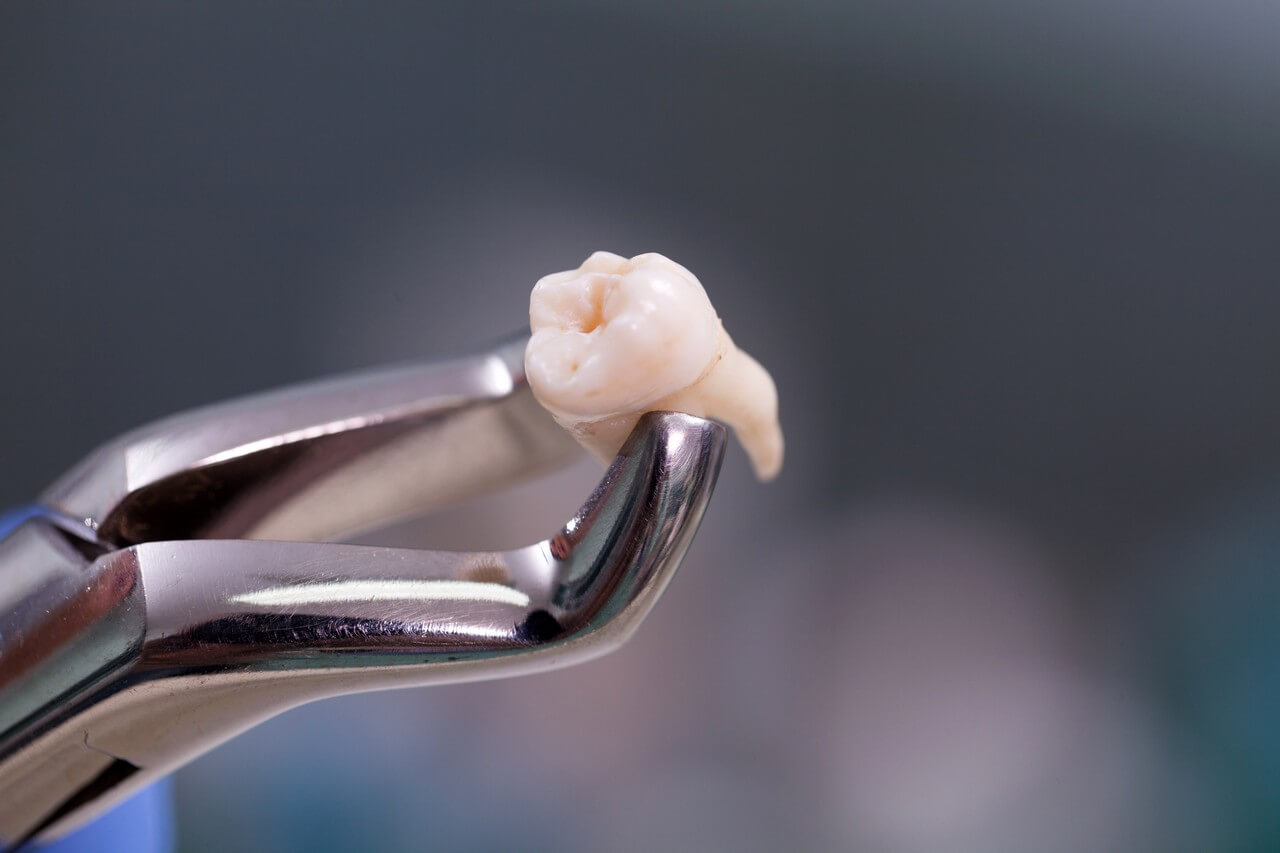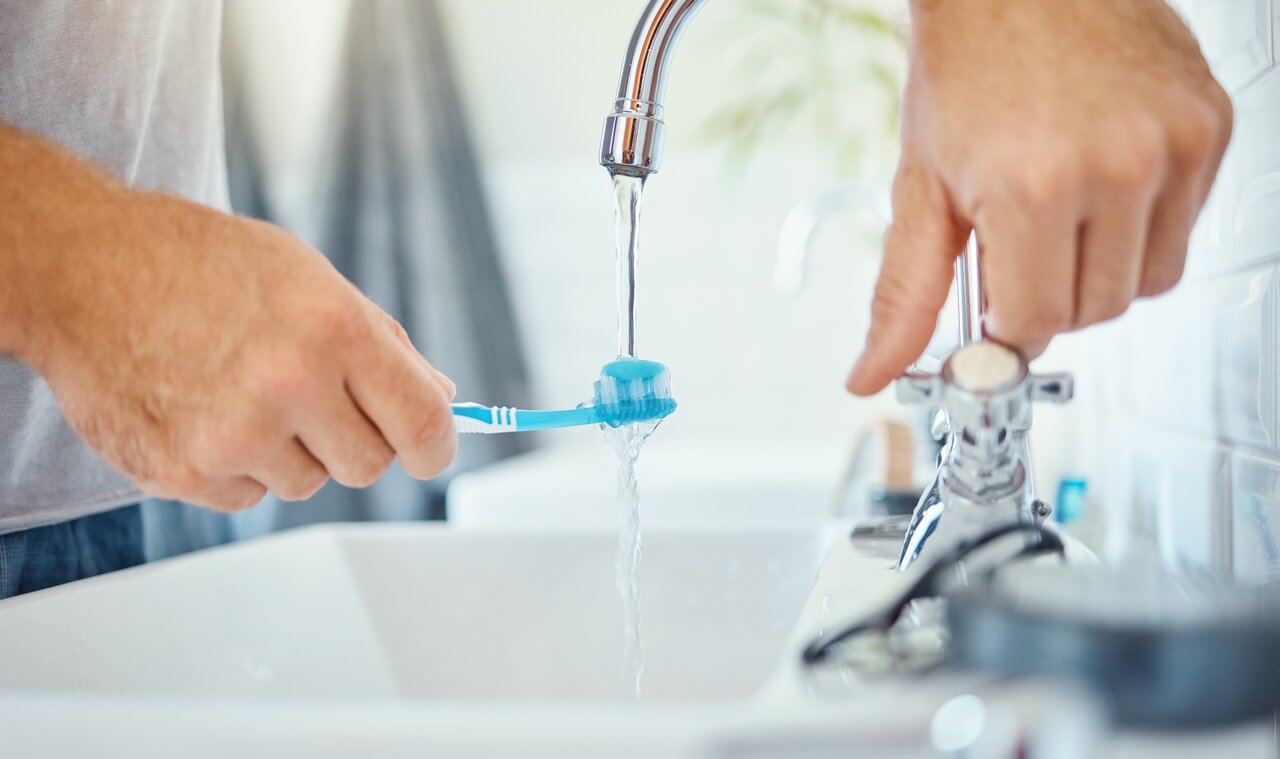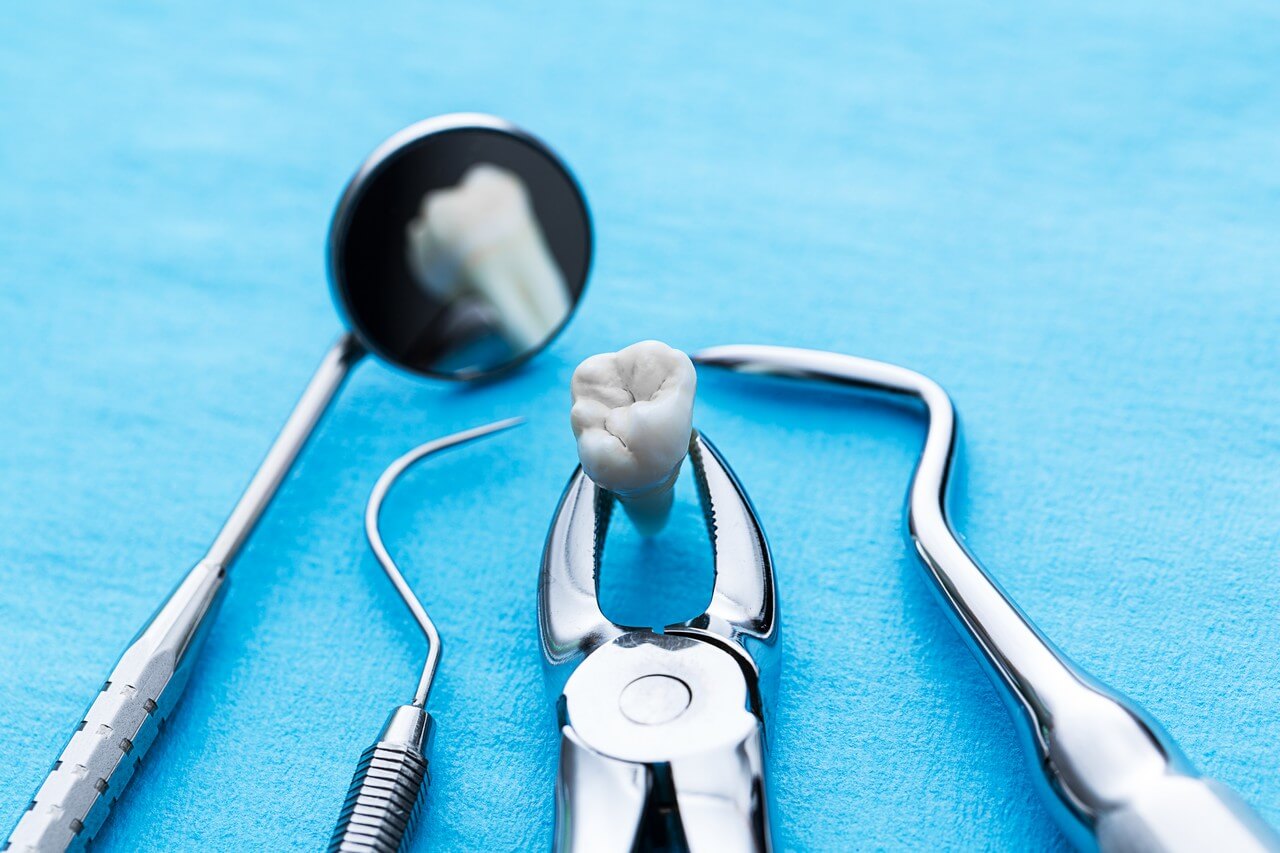Guide to Recovery from an Emergency Extraction Part 2
- Bleeding usually stops within 24 hours, while pain and swelling peak in the first few days. Healing starts quickly, but the site remains tender and sensitive.
- Cold compresses during the first 24 hours help limit swelling, while switching to warmth after day one boosts circulation and speeds recovery.
- Eating soft, cool foods like yogurt or mashed potatoes supports healing, while straws, hot, crunchy, or spicy foods can disturb the clot and slow recovery.
- Dry socket is the most common complication, causing sharp, throbbing pain a few days after extraction if the clot becomes dislodged.
- Gum tissue typically heals in 3–4 weeks, but bone repair and complete recovery can take several months before the area is fully stable.

Recovering quickly from an emergency tooth extraction comes down to proper aftercare. While the procedure itself can put stress on the gums and surrounding bone — particularly in more complex cases — the right steps afterward can make all the difference in how smoothly you heal. If you’ve recently had an emergency dental extraction in Escondido or nearby, here’s what you need to know to support a faster, more comfortable recovery.
Key points to remember
Healing time
Recovery varies, but gums usually close in 2–3 weeks, while bone can take several months to fully rebuild.
Preventing complications
Protect the blood clot, avoid suction actions, and carefully follow your dentist’s instructions to ensure safe healing.
Dry socket warning
Sharp, throbbing pain spreading to the ear or jaw with an empty-looking socket may signal dry socket — seek care quickly.
Diet choices
Choose soft, nutrient-rich foods like yogurt, soups, and smoothies. Avoid crunchy, spicy, or hot foods that can irritate.
Long-term health
Leaving gaps causes shifting teeth and bone loss. Implants, bridges, or dentures help restore stability and function.
Professional help
Persistent bleeding, worsening pain, fever, or infection symptoms are red flags that require immediate professional attention.
How long does it take for gums to heal after extractions?
Your gums actually heal faster than skin or bone. After an extraction, the initial blood clot gradually turns into fibrous tissue, though the area can still feel sensitive and bleed lightly for a while. Bleeding usually stops within the first 24 hours once the clot has fully formed. At this stage, the gum tissue around the wound is still tender, but the worst of the pain and discomfort has typically started to ease. Some swelling or inflammation is normal, but you can make this stage more comfortable by following the best practices for swelling reduction after extraction: apply a cold compress early on, then switch to gentle warmth later to encourage faster recovery.
Your gums should begin to heal 3 days after removal, but they will still be tender and swollen. You should be careful not to disrupt the healing process. Approximately 15–21 days after your procedure, the hole left by the extraction will have become nearly closed. As time goes by, the gums will begin to completely close off the hole left by the tooth extraction. Even after the healing process has been nearly completed and you no longer experience pain, discomfort, or irritation, the site may still be somewhat tender. Some patients also notice jaw stiffness after extraction, which is usually temporary and improves as the tissues continue to recover. It is the trauma to the jaw bone caused by extraction that will take longer to heal than the gum tissue itself.

What helps gums heal faster after tooth extraction?
Recovery happens quickest when the blood clot is protected, irritation is kept to a minimum, and your body has the right conditions to heal. The first 24–48 hours are especially important because this is when the clot forms and the tissue is most delicate. During this time, resting, avoiding strenuous activity, eating soft, nutrient-rich foods, and gently keeping the area clean all make a big difference in preventing infection and encouraging faster healing. Choosing foods that don’t disturb the wound not only keeps you more comfortable but also provides the nutrients your body needs to repair gum tissue.
Everyone heals at their own pace, but following these basic steps gives you the best chance at a smooth recovery. The most important thing is to stick closely to the aftercare instructions your dentist or oral surgeon provides, since those are tailored to your specific situation. Some people also look into natural remedies for faster tooth extraction recovery, but it’s always best to clear these with your dentist first to make sure they won’t interfere with the healing process.
Immediate care after extraction
It’s normal to feel unsure about what to do immediately after an emergency tooth extraction. The good news is that once you understand the basics of healing, the main thing to focus on is the first 24 hours, the most important stage of recovery. Taking the right steps early on sets the foundation for faster healing and helps you avoid complications.
Control bleeding
- Bite gently but firmly on a clean gauze pad for 30–45 minutes immediately after extraction.
- If bleeding continues, replace the gauze with a fresh one and reapply firm pressure.
- Keep your head elevated and avoid spitting, drinking through straws, or vigorous rinsing, as these can dislodge the clot and cause more bleeding.
In case you’re worried about what to do if the tooth extraction site won’t stop bleeding, the safest step is to contact your dentist right away.
Reduce swelling
- Apply an ice pack (or a bag of frozen peas wrapped in a towel) to the cheek near the extraction site for 10–15 minutes at a time, then remove it for the same amount of time before reapplying.
- Repeat this cycle during the first 24 hours to limit swelling and bruising.
- Keep your head slightly elevated when lying down to reduce blood flow to the area.
- After the first day, switch to gentle heat. Using a cold vs warm compress for swelling after extraction approach — cold early to control inflammation, then warm to promote circulation — is one of the simplest and most effective ways to stay comfortable during recovery.

Pain relief
Patients often ask how long does pain last after tooth removal, so here are some ways to reduce discomfort significantly and fairly quickly:
- Over-the-counter painkillers such as ibuprofen or acetaminophen are usually effective, but always follow your dentist’s or oral surgeon’s specific instructions.
- Avoid aspirin, as it can thin the blood and potentially increase bleeding.
- Take pain medication before the numbness fully wears off to stay ahead of discomfort.
Diet and hydration
These simple tips make up the best diet for recovery from emergency extraction:
- Stick with cool, soft foods like yogurt, applesauce, smoothies, mashed potatoes, and pudding.
- Avoid hot, crunchy, spicy, or acidic foods and drinks that may irritate the wound or dissolve the clot.
- Stay hydrated with water, but avoid alcohol, carbonated drinks, and caffeine in the first 24 hours.
Oral hygiene
Taking care of your oral hygiene properly after an extraction makes all the difference in how well and how quickly you heal. It is for this reason that one of the biggest concerns patients have is when they can brush your teeth after a tooth extraction. The safest approach is to wait at least 24 hours, and even then, brush very gently while avoiding the extraction site so the blood clot isn’t disturbed. After the first day, you can also start rinsing with a mild saltwater mix (½ teaspoon of salt in 8 oz of warm water). The key to how to use saltwater rinse properly after tooth removal is to be gentle — swish lightly and let the rinse fall out of your mouth rather than spitting, which can disrupt the healing process.
Activity level
If you’re wondering when you can exercise after a tooth extraction, the short answer is not right away. Your body needs at least 24 hours of rest to protect the clot and start healing. Pushing yourself too soon can raise blood pressure and lead to renewed bleeding, so wait until you feel comfortable and get your dentist’s approval before returning to strenuous activity.
Sleep
Your sleep position also matters. Elevating your head slightly is the best sleep position for faster healing after extraction, since it reduces swelling and bleeding.
Recovery Timeline: Days 2–7
After the initial 24 hours, your body shifts into active healing mode. Here’s what you can expect and how to care for the site through the first week:
Day 2–3: Early Healing
- Swelling may peak during this period, then begin to decrease.
- Switch from ice packs to warm compresses on the outside of your cheek to encourage blood flow.
- Continue with soft foods — try oatmeal, scrambled eggs, soups (lukewarm), or smoothies.
- Gentle saltwater rinses should be done 2–3 times daily to keep the area clean.
Day 4–5: Stabilization
- Pain and swelling should start improving noticeably.
- You may notice the extraction site forming a white or yellowish layer — one of the signs of proper healing after the extraction rather than infection.
- Gradually reintroduce slightly firmer foods like pasta, rice, or well-cooked vegetables, but chew on the opposite side.
- Maintain excellent oral hygiene while still avoiding direct contact with the wound.
Day 6–7: Tissue Repair
- The gum tissue begins closing over the socket.
- Most normal activities, including light exercise, can usually be resumed if your dentist has not advised otherwise.
- Mild tenderness may remain, but pain should be minimal.
- Continue saltwater rinses until the site feels fully comfortable.

What is the most common complication after tooth extraction?
Dry socket is the most common complication following tooth removals, such as the removal of third molars, also called wisdom teeth. This is why most patients often wonder how to know if they have a dry socket.
The telltale signs are sharp, throbbing pain that starts a few days after the extraction and doesn’t improve with regular pain medication. It may spread to your ear, jaw, or temple, and the socket itself may look empty because the blood clot is missing. Since over-the-counter medicine usually isn’t enough to manage it, your dentist or oral surgeon can provide targeted treatment to ease the discomfort.
How to swallow to avoid dry socket?
You don’t need to change how you swallow to avoid a dry socket, as swallowing itself won’t cause a problem. The real concern is avoiding actions that create suction or extra pressure in your mouth. That means it’s perfectly safe to swallow naturally and gently.
Best practices when swallowing
- Swallow normally: Don’t force it, gulp, or try to “pull” liquids back with effort. Just let your throat muscles do their job.
- Sip, don’t gulp: Take small sips of water rather than big gulps. This keeps pressure low in your mouth and throat.
- Stay upright: Sit up straight when drinking or eating so liquids and food move down smoothly.
What to avoid
- No straws: Sucking through a straw creates negative pressure that can dislodge the clot.
- No spitting: Spitting forcefully is risky for the same reason — it pulls at the healing site.
- No exaggerated swallowing motions: Trying to swallow with extra force or “sucking” can disturb the area.
Other possible complications
Most people heal without issues, but sometimes problems can slow recovery. Keep an eye out for these warning signs:
- Infection: Ongoing swelling, fever, or a bad taste in your mouth can point to infection. Call your dentist right away if you notice these symptoms.
- Prolonged bleeding: Some light bleeding is normal, but if it hasn’t slowed down after 24 hours, it’s important to get checked.

Patient-specific recovery needs
Recovery is not the same for everyone. Age, health conditions, and the type of tooth removed can all influence healing time and the level of care required:
- Children usually bounce back faster, but they still need guidance. Simple recovery tips for children after extraction include reminding them not to touch the area with their fingers or tongue and encouraging soft foods that won’t disturb the site.
- Seniors may experience a slower healing process due to age-related changes in tissue regeneration. In addition, many older patients take medications that can affect blood clotting, pain management, or immune response. A careful review of medications and close follow-up are key to preventing setbacks.
- Patients with diabetes or compromised immune systems face a higher risk of infection and delayed healing. Maintaining stable blood sugar levels, following prescribed antibiotics (if given), and keeping a close watch on the site for swelling or unusual pain are critical steps in their recovery.
- Wisdom teeth vs. regular teeth: One more key factor is how extraction recovery differs for wisdom teeth vs regular teeth. Wisdom teeth are often impacted and sit deeper in the gum and bone, which makes the procedure more involved and the healing period longer. This added trauma can lead to more swelling, discomfort, and limited jaw movement. Regular teeth, on the other hand, usually require less disruption and tend to heal more quickly with fewer complications.
By tailoring aftercare to each patient’s unique circumstances, dentists and oral surgeons can help ensure a smoother recovery and reduce the risk of complications.
How do you know if your gums are healing after a tooth extraction?
You’ll know your gums are healing after a tooth extraction if new gum tissue has formed at the site and the area looks and feels less tender. About one month after the procedure, the extraction site will usually be covered with fresh gum tissue, though you might still notice a small indent where the tooth once was.
Healing timeline for gums and bone
- First week: The gum starts closing and the jawbone begins healing underneath.
- Around 10 days–2 weeks: Most swelling and tenderness should reduce significantly, and the gum tissue will be noticeably firmer.
- 4 weeks: New gum tissue has filled in the area, and discomfort is typically gone.
- 10 weeks: New bone tissue begins to fill the socket, strengthening the area.
- 4 months: Bone continues to grow and usually fills the majority of the space.
- 8 months: The new bone edges become level with the surrounding jawbone.
Signs of proper healing
- The gum looks pink and healthy, not red or inflamed.
- Pain is minimal or gone.
- No bleeding or discharge is present.
- The extraction site steadily looks smaller and smoother over time.

Long-term considerations
Once your mouth has healed, it’s important to plan for the future health and function of your smile. Leaving an empty space where a tooth was removed can affect both your bite and the overall structure of your jaw. Key points to keep in mind include:
1. Tooth replacement options
What happens if you don’t replace a tooth? Nothing good. Gaps left after extraction can cause nearby teeth to shift and lead to bone loss over time. Here are some of the solutions to consider:
- Dental implants for a permanent, natural-looking replacement.
- Dental bridges to fill the gap by attaching to neighboring teeth.
- Partial dentures as a removable, more affordable option.
2. Timing of the treatment
Most implants are placed several weeks after extraction, once the gums and bone have stabilized, but your dentist will recommend the best timeframe for your situation.
3. Bone health
In some cases, a bone graft may be advised at the time of extraction or afterward to preserve jawbone structure and create a strong foundation for future restorations.
Taking these steps ensures your bite remains stable, your jaw stays healthy, and your smile looks and feels complete for years to come.
When to call your dentist
While mild discomfort, swelling, and light bleeding are normal after the procedure, certain symptoms mean you should contact your dentist right away. Seek care if you have:
- Severe or worsening pain that doesn’t improve with medication
- Bleeding that continues beyond 24 hours
- Signs of infection such as fever, pus, persistent swelling
- A foul taste in your mouth.
- In rare cases, difficulty opening your mouth, swallowing, or breathing requires urgent medical attention.
Once your mouth has healed, it’s also a good idea to call your oral surgeon in case you have questions about tooth replacement options, or if you’re experiencing problems related to the gap, such as shifting teeth, bite changes, or concerns about bone health. They can guide you through solutions that fit you best.

Expert emergency dental extractions for patients in Escondido & nearby areas
Here at Temecula Dental Implants & Oral Surgery, we care about your satisfaction and well-being. Whether it’s a planned procedure or an emergency one, we take a consistent approach to patient care. We are diligent about preparation, execution and follow-up, and we will ensure your safe and smooth recovery so you can start organizing that long-awaited family picnic at Dixon Lake. Get in touch with us now!

